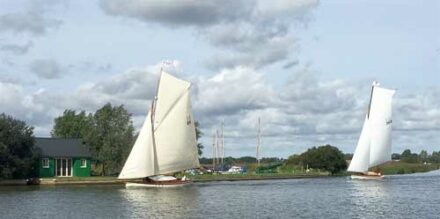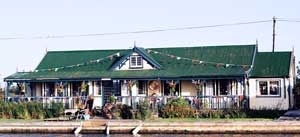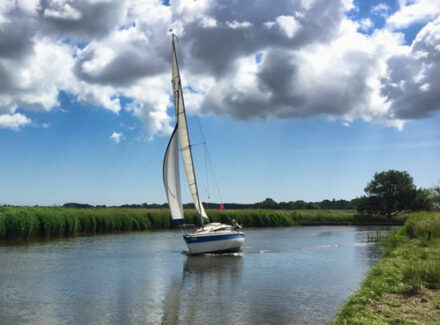A Summer in the Norfolk Broads
 Sailing Craft on the River Thurne
Sailing Craft on the River Thurne
The year 2020 was when Mother Nature gave humanity a resounding kick up the backside. The coronavirus has reminded us that even though we are the head of the food chain on the planet, she will always have the upper hand. Fortunately, the UK government’s lockdown rules to control the virus’s spread did allow us to leave our North Norfolk homes to take exercise. That got me thinking about how I could do something constructive with the weeks of lockdown. I love to walk in the countryside, so I decided to spend a summer in the Norfolk Broads and make a photographic record of my wanderings.
I am an early riser; a great advantage if you are interested in seeing wildlife. In fact, getting out into the countryside early in the day has many benefits. The beautiful morning light, the sound of geese and ducks, birdsong and the rustling of reeds accompanied my walks in Broadland: very relaxing.
Having studied the OS Explorer map OL40, I selected Potter Heigham as an ideal base. From the village, I could access several footpaths, including Weavers’ Way. The Norfolk Wildlife Trust Reserve of Hickling Broad is a short drive away, as are the Broadland villages of Thurne, Horsey (where wildlife boat trips are available) and Ludham.
My favourite walk starts at the church in Potter Heigham. From there, a footpath leads through some dense woodland towards Weavers’ Way running west to east. Crisscrossed by numerous exposed tree roots, the path is muddy, so care is needed. Exiting the tree line, you cross a small bridge that takes you up onto the raised bank that is Weavers’ Way. Then, spread out before you, is the southern edge of Hickling Broad with its fringe of thick reed beds.
Arriving at the broad when the sun was still very low on the horizon, I would hear the chattering of hundreds of wildfowl. The geese are predominant and watching a huge flock of them take flight to head off to the feeding grounds is a wonderful experience.
Marsh harriers, circling as they scanned the ground looking for their breakfast, were a common sight. Sometimes I would surprise a grazing roe deer. Usually seen singly in summer, the animal’s head would jerk up as it heard or scented my approach. Standing very still the deer would stare at me for a few seconds and then bound off, its distinctive white rump highlighted by the early morning sunlight. Also seen regularly were the less attractive muntjac. They are now ubiquitous in this part of Norfolk and are less shy than roe deer. They wander off into cover rather than run.
On a still, warm and dry morning, I would see the beautiful Swallowtail butterfly. It is unmistakable, with its pale yellow, blue margined and black veined wings. It is a spectacular sight but is now, sadly, extremely rare in the UK and is restricted to the Norfolk Broads. A powerful flyer, it lands to feed on the flowers of milk-parsley, ragged-robin and thistle.
From April, I began to hear the cuckoo’s call and on one occasion I was lucky enough to see one. It was perched on a branch of a dead tree and was repeatedly calling. In the distance, I could hear another responding with that unique call. Unfortunately, the cuckoo’s song is becoming a rare sound in the Norfolk countryside.
Turning east onto the path, you walk along the broad’s edge with the mixed woodland of Wagonhill Plantation to your right. Further on you pass Sound Plantation with the waterway named Heigham Sound to your left. At that point, the woodland ends and to the west is a flat landscape of fields dissected by farm tracks. The channel then becomes Candle Dyke and is wide enough to be called a river. It continues to widen as it heads to its confluence with the River Thurne.
 The path turns to the west when you reach the Thurne and continues along the bank. The banks of the Thurne are home to many unique and, in some cases, eccentric riverside bungalows. The lack of planning controls allowed their construction in the early part of the twentieth century. Over the years many of the little dwellings have been replaced, while some of the original structures have been modernised and are carefully maintained. Their owners love them, as evidenced by the fresh paint and well-tended garden plots. They don’t often come up for sale but when one does become available it sells almost immediately at a very high price.
The path turns to the west when you reach the Thurne and continues along the bank. The banks of the Thurne are home to many unique and, in some cases, eccentric riverside bungalows. The lack of planning controls allowed their construction in the early part of the twentieth century. Over the years many of the little dwellings have been replaced, while some of the original structures have been modernised and are carefully maintained. Their owners love them, as evidenced by the fresh paint and well-tended garden plots. They don’t often come up for sale but when one does become available it sells almost immediately at a very high price.
To complete the walk you follow the bank of the Thurne until the path turns right across some fields. It takes you to Marsh Road from where it is a short walk back to the church.
When the lockdown eased, the situation changed dramatically. The quiet was no more and the rivers became very busy. With their crews of excited holidaymakers, the hire boats motored out of the Herbert Woods boatyard, a leading provider of cruising holidays on the Norfolk Broads.
This summer in the Norfolk Broads was a delight. I learned a lot about the area and the creatures that live there and I certainly benefitted from the healthy exercise. However, the lockdown summer of 2020 will live long in our memories as a trying and sad time for many people.
During 2021, I hope to regularly visit the Norfolk Broads to continue exploring this beautiful part of England.
Potter Heigham Church – Sat Nav: NR29 5LN
OS Explorer OL40: The Broads.
